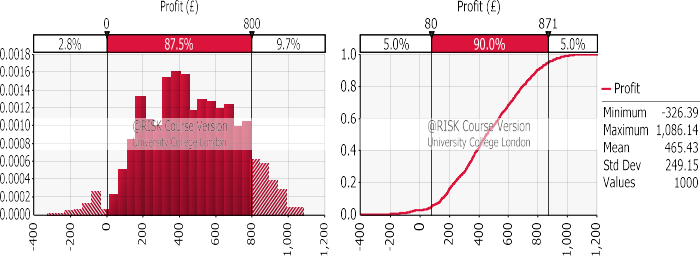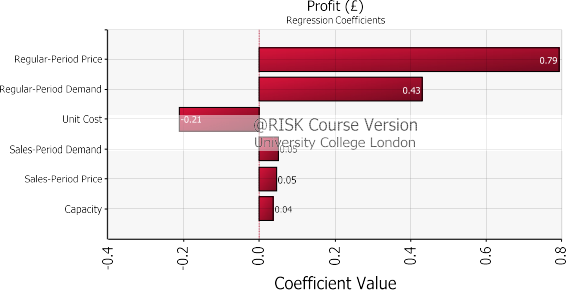关键词 > MSINM014/MSING014/MSING014B
MSINM014/MSING014/MSING014B DECISION & RISK ANALYSIS ─ 2015 FINAL EXAM
发布时间:2023-08-12
Hello, dear friend, you can consult us at any time if you have any questions, add WeChat: daixieit
MSINM014/MSING014/MSING014B
DECISION & RISK ANALYSIS ─ 2015
FINAL EXAM
Part I: Simulation
Mark, the procurement director of the Waterstones store in Gower Street, needs to place an order for the next year’s diaries. He think that each diary will sell for anywhere between £8 and £12 during the months of November through February (regular period). According to historical data of Gower Street branch, customer demand for diaries during this regular period will most likely be 175. The minimum and maximum demand for diaries during this period is 100 and 300, respectively. Waterstones supplier has limited capacity and may not be able to supply all diaries requested by the Gower Street branch. Mark believes that the maximum number of diaries the supplier can deliver is most likely 200 with minimum 125 and maximum 250. Once Waterstones Gower Street branch places the order, the supplier will charge anywhere between £6.50 and £7.50 per diary.
Unsold diaries cannot be returned to the supplier for a refund. Instead, after the regular period starting March (sales period), Waterstones must put them on sales price (discounted) anywhere between £4 and £6 per diary. Again based on historical data, the demand for diaries at Waterstones branch in Gower Street during this sales period is between 0 and 75 with 50 being the most likely. Any diaries left over after the sales period will be thrown away.
Question 1. Scenario Analysis
Using the most likely estimates for demand at regular and discounted prices, and the best guess of the supplier’s capacity, Mark decides to order 200 diaries.
(i) Using the key uncertainties (risk factors) and assuming the order quantity (i.e., number of diaries) is 200, determine the equation for the diary profits at Waterstones Gower Street (i.e., revenue at the regular price + revenue at sales price - costs).
(ii) Assuming the order quantity is 200, what are the best-case and worst-case scenarios based on the profit equation you obtained in part (i)? What is the range for the profit?
Question 2. Simulation - Input Distributions
To perform a simulation analysis, we need to identify an appropriate probability distribution to model each of uncertainties (risk factors). What are the uncertainties (risk factors) for Waterstones at Gower Street branch? Determine an appropriate distribution and their parameters for each of the risk factors.
Question 3. Simulation – Discussion of the Results
Assuming that the number of diaries ordered is 200, you have used the distributions specified above to perform a simulation analysis (1,000 iterations) using @Risk and produced the following output.

(i) Determine the average profit of Waterstones when the number of diaries ordered is 200, and carefully explain what it means.
(ii) What is the likelihood that the profit is positive? What is the probability that the profit is £800 or more? What are the realistic downside and upside in terms of the profit level?
Question 4. Managing Risk – Sensitivity Analysis
Examine the tornado diagram from the @Risk.

(i) What information does a tornado diagram provide in general? What do you observe from the tornado diagram above?
(ii) Is it worth money and time to reduce the variability in price and demand in regular period? How about price in sales period?
Question 5. Optimization via Simulation – Comparing Alternatives
We run four simulations for four different order quantities. Simulations 1 to 4 corresponds to the order quantities 125, 175, 225, and 300, respectively, and each simulation has 1000 iterations. The following table summarizes average profit, probability that Waterstones loses money, and value at risk at 5% (realistic downside) and 95% (realistic upside) corresponding to each simulation (order quantity).

(i) Using the above table, compare order quantities 125 vs. 175; 175 vs. 225; and 225 vs. 300.
(ii) Which of the four order quantity would you choose? Why? Explain your reasoning clearly.
Part II: True or False
Question 6. Circle “T” if the statement is true and “F” if the statement is false.
(i) (T / F) In simulations, there will be a significant difference in the VaR at 5% between
running 1000 iteration and running 5000 iterations.
(ii) (T / F) In an optimization model with the objective of maximizing revenue,
eliminating a constraint will always lead to an increase in the optimal revenue.
(iii) (T / F) The goal of simulation analysis is to predict the future events better.
(iv) (T / F) If an optimization model has a linear objective function, the excel solver can
always find the optimal (“best”) solution.
(v) (T / F) In decision trees, value of information about a risk factor can be greater than
the value of controlling the same risk factor.
Part III: Decision Analysis
Waterstones, the entire chain, is facing competitive pressures from online book sellers (e.g. Amazon.co.uk) and the emergence of e-books (e.g. Kindle). To increase its book sales and to take the best advantage of its existing business model, Waterstones is reviewing the viability of transforming Waterstones from a bookstore into an old-fashioned “reading lounges” with books. More specifically, it wants to increase the “dwell time” of its customers to revitalize the reading culture in the UK, and also to encourage customers to purchase books online from their own online shop while they are in the Waterstones stores (e.g. using easily accessible store iPads). They believe that the cozy lounge and coffee shops not only can attract readers and buyers, but also provide additional revenue that can subsidize their book operations to reduce book price, enabling them to compete with online book sellers.
If Waterstones maintain the status quo business model, analysts estimate the present value of future revenue at £150M. If Waterstones decides to undertake the transformation, it requires upfront investment of £50M to refurbish all of their stores and launch the coffee shop operations, and invest in warehouse to store their books. In return, the present value of future revenue can potentially increase by 33% (to £200M). However, such increase is not guaranteed, and the present value of future revenues may stay the same (£150) with equal likelihood.
If Waterstones undertakes the transformation and the present value of future revenue increases, it can decide further to compete head on with the major online book-sellers. Specifically, a further investment of £20M can streamline their online operations (e.g. enhanced website, warehouse, and global supply chain) to take market shares from other major online book-sellers. Such investment, if successful, can drive up further increase in book sales, leading to a present value of future revenues of £400M. However, there may be reactions from the major online book-sellers (e.g. through further price-cuts) making the revenue stay the same. The probabilities are, again, equally likely.
Question 7. Decision Tree
(i) What are the key decisions and uncertainties facing Waterstones?
(ii) Construct the decision tree.
Question 8. Risk Profiles
State the optimal strategy and the risk profiles associated with the optimal strategy.
Question 9. Value of Control
Waterstones is investigating the option of a formal (large-scale) partnership with a major coffee brand, Costa. Because Waterstones had previous relationships at select Waterstones stores (e.g. at Gower Street), it knows that Costas will attract book buyers and bring in extra revenues. With favourable terms of negotiations, Waterstones believe that their chance of increasing their revenue to £200 can be increased to 60% (from 50%). Waterstones wants to know what that value is.
(i) Construct the new decision tree.
(ii) How much is it worth partnering with Costa?
Question 10. Value of Information
Executives at Waterstones was recently made aware that Amazon.co.uk has found out their potential plan to compete in the online book market. Amazon is now taking preventive measures against potential competition. As a result, Waterstone can no longer afford to wait and see whether the revenue would increase or not to make the additional £20M investment. Instead, it must invest the total sum of £70M (£50M+£20M) directly and transform itself and compete online. If the revenue does not increase after transformation, the present value of future revenues will stay the same at £150M, and Waterstones will not attempt to compete head-on in the online market. However, if the revenue does increase after transformation, Waterstones will be able to compete in the online market immediately.
(i) Construct the new decision tree.
(ii) How much value was lost from the leakage of information to Amazon.co.uk?

